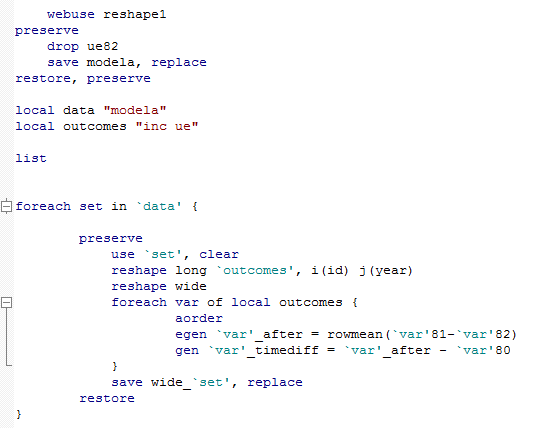
Replace residuals = `temp' if group = `x' What we did below is creating a temporary variable temp that stored the residuals from regressions within each group. Tempvar assigns names to the specified local macro that may be used as temporary variables in a program. UCLA: Statistical Consulting Group, How Can I Access Information Stored after I Run a Command in Stata (Returned Results)? | Stata FAQ tempvar Outside loops, levelsof can display the unique values of a variable. ttest writing_gpa if writing_level = `x', by(gender) In loops, levelsof is useful to store the values of a variable in a local macro for later use by specifying the local() option. We can use Stata system variables to obtain coefficients and standard errors: To use the matrices later, we need to first store the matrices: To list the matrices of stored results, we can

Predicted probabilities on samples used in the previous estimation outreg2 using myfile, adds(F-test, r(F), Prob > F, r(p)) replace twoway (lfitci mpg weight) (scatter mpg weight), note(R-squared =`r2')Īdding stats from postestimation in tables In order to be able to use the mean of mpg later, we can: The results will be lost the next time you run another r-class command. Let’s review some examples below where we use the stored results for various purposes.
#Stata local full
Which gives us the full lists of the results that the command regress offers. To see what the result lists actually look like, try typing Matrices: e(b) coefficient vector and e(V) variance–covariance matrix of the estimates (VCE)įunctions: the only function existing is e(sample), which evaluates to 1 (true) if the observation was used in the previous estimation and to 0 (false) otherwise. If we need to store the returned results, we need to use a macro. Results will be replaced the next time you execute another command of the same class. N-class commands that do not store in r(), e(), or s()Ĭ-class system parameters and settings that store in c()Ĭommands producing statistical results are either r-class or e-class: e-class for estimation results and r-class otherwise.įollowing the r-class or e-class commands, we can obtain all the stored results of a command by typing return list or ereturn list respectively. S-class parsing commands that store results in s() used by programmers R-class general commands that store results in r()Į-class estimation commands that store results in e() There are five classes of Stata commands: Results of calculations are stored by Stata commands so that they can be accessed in other commands and calculations later.

Stored Results r-class and e-class commands


 0 kommentar(er)
0 kommentar(er)
